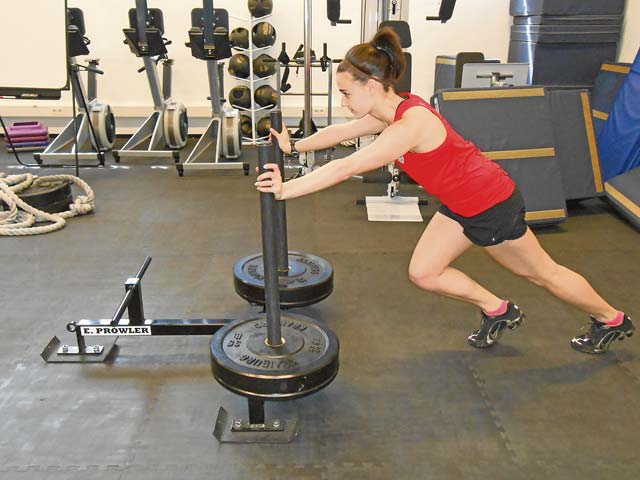by Sarah Clum
Ramstein Health and Wellness Center health and fitness specialist

Sarah Clum, Ramstein Health and Wellness Center health and fitness specialist, performs sled training as high intensity interval training.
Would you like to intensify your workouts? Have you reached a plateau and don’t know what to try next? Would you like to get the benefits of an hour-long cardio workout in a fraction of the time?
If any of these raised an eyebrow, high intensity interval training, or HIIT, may be for you.
HIIT, involves alternating bursts of high-intensity effort, reaching close to 90 percent maximum heart rate, with lower intensity recovery periods to achieve improved fitness in a shorter amount of time than through steady-state training. It works by combining anaerobic and aerobic fitness, getting the most of both types of training.
Benefits of HIIT include a metabolism boost, increased calorie consumption both during the exercise session and post-workout, faster building of lean muscle and maintenance of lean muscle throughout weight loss.
Using a professionally designed plan isn’t necessary, but it can be a great start if you are new to HIIT. Sticking to a plan helps track progress, motivates you while training and pushes you to improve. It is best for beginners to start slow and gradually build on their current fitness level. One to two interval sessions a week on nonconsecutive days allow the body to heal and replenish energy stores depleted from training.
When incorporating HIIT into your current exercise routine, you can increase the intensity in various ways, including speed, load (such as wearing a weighted vest), adding incline to a run or sprint, or decreasing the recovery time between intervals. Keep in mind it is best to increase the intensity in only one area at a time. So, focus on one specific area before moving to the next.
Whether your intervals involve running, biking or another form of exercise, it is imperative you maintain good form. Sacrificing form to complete an interval — especially at this high intensity — is a recipe for exercise-related injury.
The training plan isn’t designed to be executed for an extended amount of time. It is a great way to spice up a mundane exercise regimen, but it isn’t for the faint of heart. HIIT provides many benefits, but by doing so it is taxing on the body.
Ensure you have plenty of recovery time between workouts and pay attention to your body’s signals. Avoid an injury by decreasing the intensity of the workout or by taking time off from the high intensity training if you feel significant pain other than the average muscle soreness.
HIIT is designed for those interested in increasing cardiovascular fitness and fat loss while maintaining their lean body mass. An active warm up is an important step in the exercise program, as well as a post-interval cool down.
The high intensity intervals are designed to push you to your limits, so you should be striving to reach a point where you cross from an aerobic zone, where your body is still using oxygen for energy, to the anaerobic zone, where your body’s oxygen needs exceed its supply of oxygen and it draws from energy stored in the muscles. The energy stored is used quickly in this zone, so the body becomes exhausted quickly after entering the anaerobic zone. This is the end of the high intensity interval where you’ll transition to an active recovery interval.
If you are interested in starting HIIT, there are many resources available. You can use a program like Tabata or design one on your own. The Ramstein Health and Wellness Center is also available to give you more information about starting a training plan. You can reach the HAWC at 86amds.hawc@us.af.mil or call 480-HAWC (4292).


